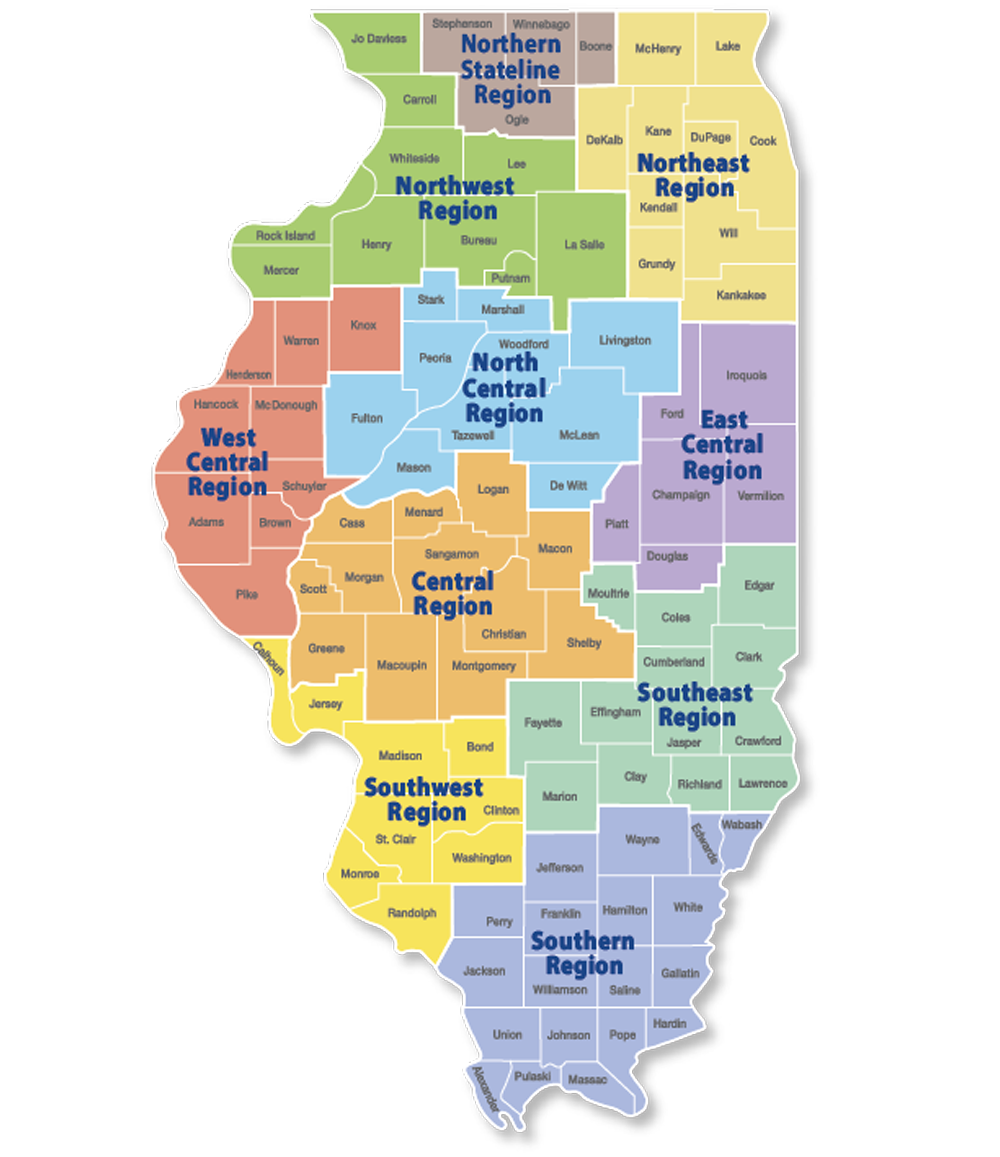How Illinois supports economic development at the local level.
by Alexis Elmore & RON STARNER
The Illinois Department of Commerce and Economic Opportunity supports economic development at the local level through the administration of 10 separate regions statewide. The following is a snapshot of each of these 10 regions.
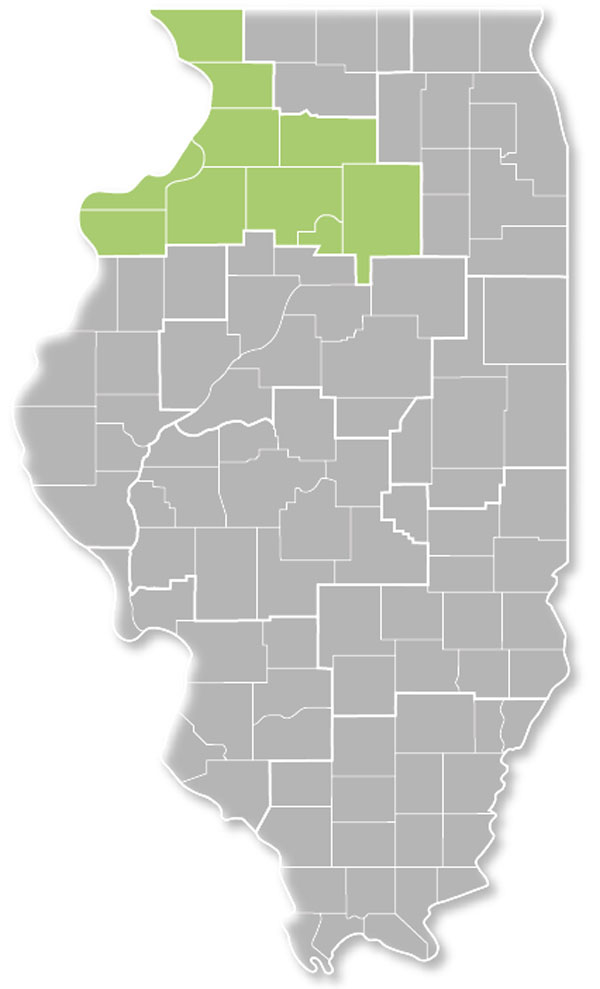
Northwest Region
Counties: Bureau, Carroll, Henry, Jo Daviess, La Salle, Lee, Mercer, Putnam, Rock Island, Whiteside
In Northwest Illinois there are plenty of ways to get connected to a quality live-work-play lifestyle. Prime outdoor recreation offerings, an array of attractions, affordable housing, a low cost of living and quality higher education institutions are just a few of the assets on hand in the region.
The 10 counties that make up the Northwest Illinois region — Bureau, Carroll, Henry, Jo Daviess, La Salle, Lee, Mercer, Putnam, Rock Island and Whiteside — are home to over 477,000 residents and climbing. These rolling hills and lush valleys stretch beyond the Mississippi River’s path to the west, resulting in generations of thriving agricultural dominance. Industry leaders such as John Deere, Bunge and Cargill sought out operations in the state and have remained firm in driving agricultural innovation in these northwest communities: Just take a look at John Deere’s over 60-year-old HQ presence in Moline. The company has continued to pour into its Illinois locations, recently wrapping up a combined $149 million renovation at its East Moline plant and a $10 million, 60,000-sq.-ft. expansion of the nearby Moline seeding facility.

The I-74 Bridge project was a collaboration between the City of Moline & the City of Bettendorf completed in 2021.
Photo courtesy of NewView Drone Services/ Visit Quad Cities
This region feeds into the larger Davenport-Moline-Rock Island metropolitan area, encompassing five cities in Iowa and Illinois, which tied for No. 6 in Site Selection’s Top 10 Mississippi River Corridor Metros rankings in 2025. The Quad Cities communities in Illinois — including Moline, East Moline, Rock Island and Silvis — are benefiting from recent infrastructure investments designed to boost connectivity in the region. Rock Island County’s MetroLINK received $1.28 million in Climate and Equitable Jobs Act funding to introduce eight new EV fast charging stations in downtown areas to boost the region’s sustainable transportation network. Meanwhile, East Moline has begun work on its $30 million Greater Downtown Revitalization Project. The goal is to ensure the city is more walkable and connected, introducing new sidewalks, bike paths, outdoor event space and more.
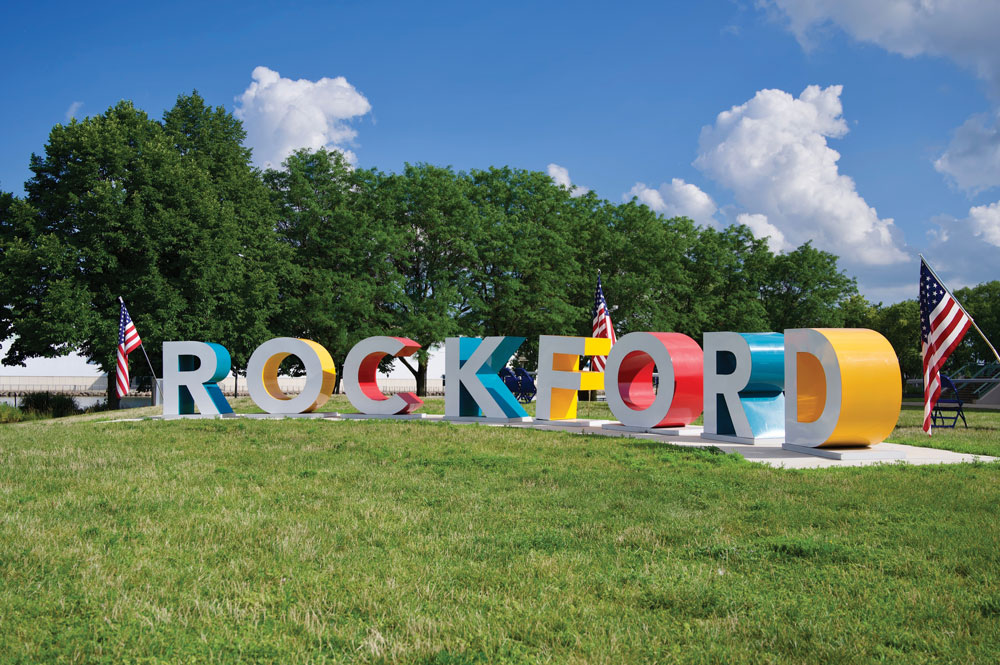
Over 56,000 engineers are within 90 miles of the Rockford metro area, a key pull for manufacturers in the region.
Photo: Getty Images
A focus on quality transportation infrastructure and direct access to Interstates 39, 88, 74 and 80 support a robust logistics and warehousing industry in the state’s northwest. Amazon is in the midst of constructing a new last-mile delivery facility at the Ottawa Industrial Park located in La Salle. Once complete, the 50,800-sq.-ft. warehouse will aid the company in improving delivery times while expanding its regional logistics network.
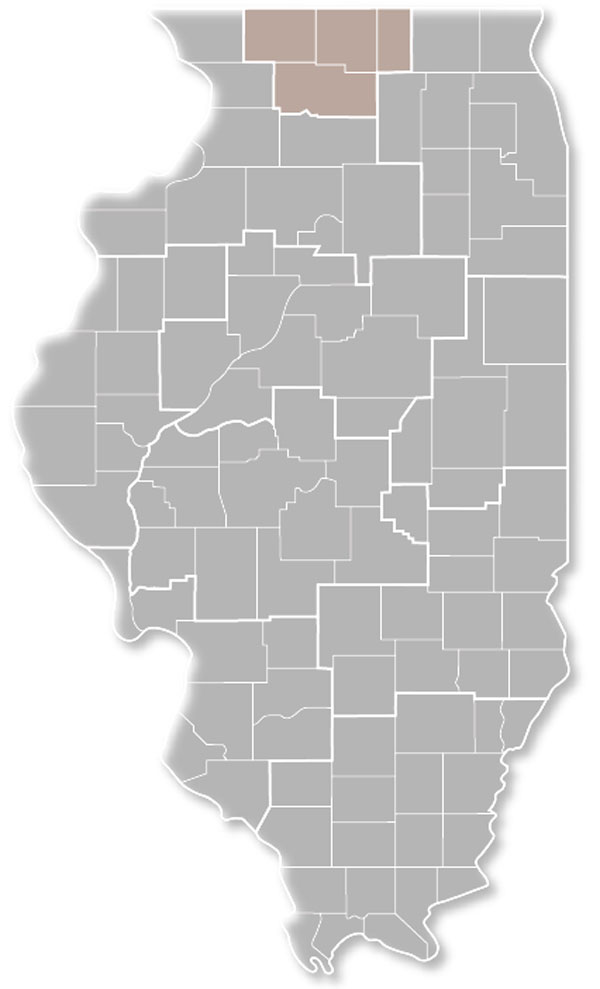
Northern Stateline Region
Counties: Stephenson, Winnebago, Boone, Ogle
The four-county cluster of the Northern Stateline region is best known for its ability to support advanced manufacturing needs. Stephenson, Winnebago, Boone and Ogle counties are home to more than 436,000 residents combined and have become a hot spot for food & beverage, health care, aerospace and automotive industry production. Such concentration allows for higher education institutions such as Northern Illinois University, Rockford University, Highland Community College, Rock Valley College and the University of Illinois College of Medicine at Rockford to collaborate with local manufacturers to develop and update curriculum and training opportunities for local talent.
The city of Rockford, which rests in the heart of the Stateline region’s Winnebago county, has previously been ranked as a top five location to work in manufacturing by IndustryWeek, bolstered by operations from Collins Aerospace, Stellantis, Woodward, General Mills, GE Aviation and more in the area. Over 56,000 engineers are located within 90 miles of the Rockford metro area, whose local concentration of more than 4,000 skilled engineers represents 30% more than the national average.
Within the past year, the Stateline region has landed a $45 million facility investment from data security systems manufacturer Hennings, Inc. in Machesney Park; an $18 million arrival from Piranha to begin metal-cutting manufacturing and assembly in Belvidere; an expansion of Zekelman Industries’ Wheatland Tube manufacturing plant which created 200 new jobs in Rochelle; and a $10 million investment to expand and upgrade equipment at J.L. Clark’s Rockford metal packaging plant.
By 2027, Stellantis plans to revamp its Belvidere Assembly Plant after moving away from plans to integrate EV battery production at the site. The company will now instead move forward with production of a brand new mid-sized truck at the facility, although further details on the project have not been announced. Once operational, the Belvidere facility will welcome back 1,500 employees.
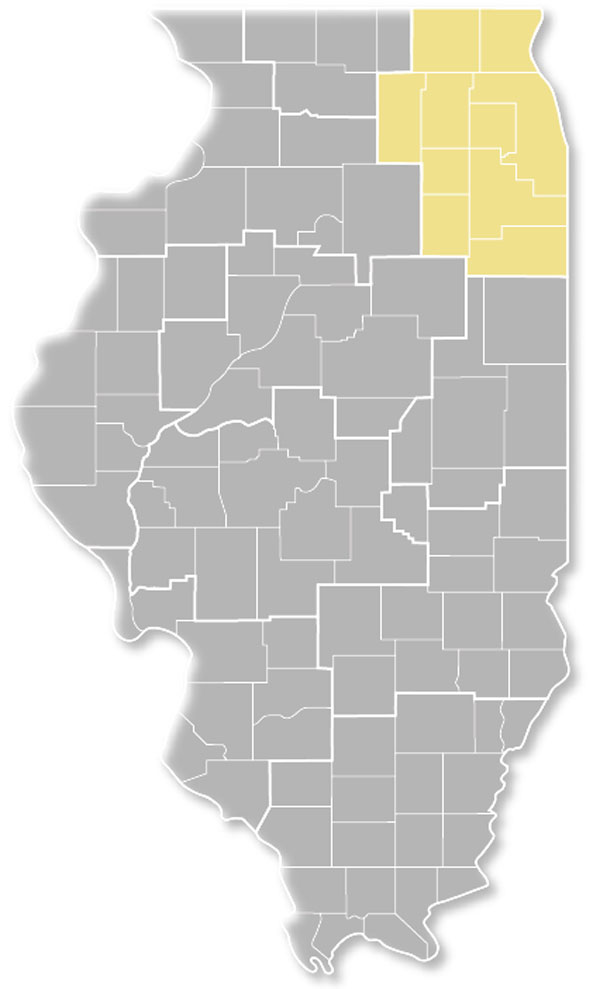
Northeast Region
Counties: Cook, DuPage, Lake, Will, Kane, McHenry, Kendall, Kankakee, DeKalb, Grundy
It would be difficult to ignore the economic impact of Northeast Illinois. A regional workforce of over 4 million residents have transformed this 10-county spread, becoming a pillar for IT, energy, life sciences, advanced manufacturing and food & beverage industries.
Of the state’s roster of 32 Fortune 500 corporate HQs, 24 of those are located in Chicago. Archer Daniels Midland, AbbVie, Exelon, Kraft Heinz, McDonald’s, Mondelez International and United Airlines are just a few of these heavyweights.
Regardless of industry, the state’s northeast has become a playground for the innovative. Leading higher education institutions such as the University of Chicago and Northwestern University, paired with dedicated innovation environments such as mHUB, the Chan Zuckerberg Biohub, 1871 or any number of local university or corporate-led innovation centers, churn out a steady supply of both skilled talent and daring entrepreneurial pursuits.

The Chicago-Naperville-Elgin metro area attracted over 580 new project investments in 2024.
Photo courtesy of Illinois Office of Tourism/ Dice Sales
As start-up battery technology company Pure Lithium Corporation looks to scale its future commercial operations, the manufacturer announced in July a full relocation will be made from Boston, Massachusetts, to Chicago. The city provides the infrastructure and talent needed to effectively transition from R&D at its pilot facility into successful long-term production, company leaders said.
“Our new facility in Chicago aligns with the company’s long-term operational goals and growth strategy,” said Pure Lithium Founder and CEO Emilie Bodoin. “This move allows us to construct a semi-automated battery pilot line vertically integrating our lithium metal reactor, and the incentives assist in funding critical pilot equipment, accelerating our timeline to market.”
The $46 million investment, supported by Reimagining Energy and Vehicles in Illinois (REV Illinois) incentives, will establish a new HQ and manufacturing site located in the Fulton Market district. Pure Lithium anticipates production of the first commercially viable lithium metal battery to commence by the end of the year.
Beyond the hustle and bustle of life within Cook County’s renowned Windy City, regional hubs including Aurora, Joliet, Naperville, Elgin, Waukegan and Cicero have also found themselves at the center of domestic and international corporate growth strategies. The greater Chicago-Naperville-Elgin metro area was named as Site Selection’s No. 1 Top Tier 1 Metro by projects in 2024, as 582 project announcements landed throughout the region last year. Low energy costs and access to computing facilities like PsiQuantum led to a regional data center boom, as billions of investment dollars were announced throughout Northeast Illinois from developers Compass Datacenters, T5 Data Centers, QTS and more.
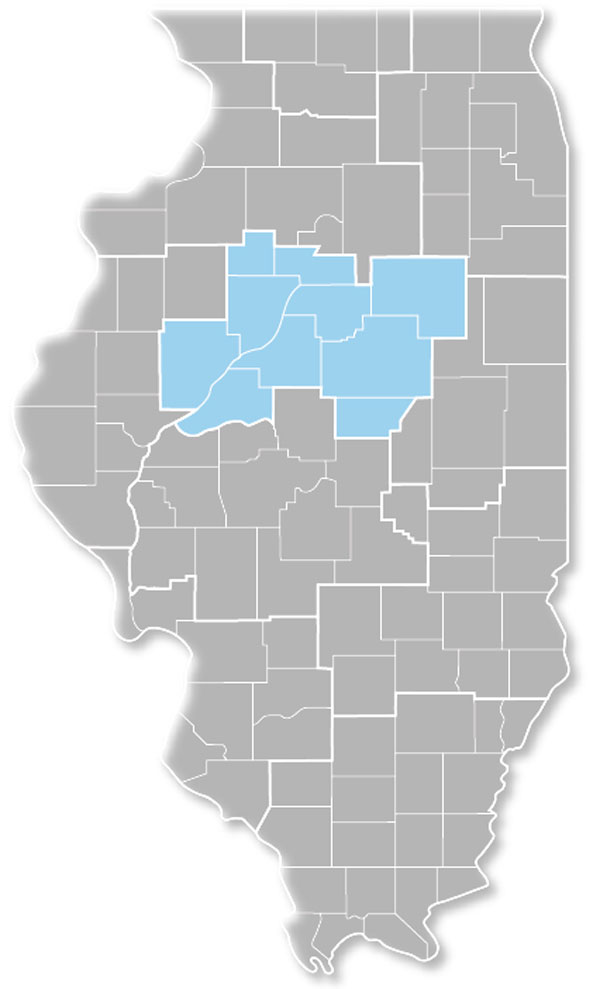
North Central
Counties: Peoria, McLean, Tazewell, Woodford, Livingston, Fulton, DeWitt, Mason, Marshall, Stark
Once manufacturers discover the capabilities of North Central Illinois, they’re in no rush to leave. Those capabilities have kept the likes of Caterpillar, Ferrero, Komatsu, Maui Jim and Rivian locked in on the region for years. Just as importantly, these communities have supplied ample space to support growth of their respective industry ecosystems.
For Rivian, this means investing $120 million to construct its own supplier park to feed its EV manufacturing facility in Normal, which is currently undergoing a $1.5 billion expansion. By investing in this new space, the company looks to welcome vital suppliers to plant roots in Illinois, as the company looks to expand its production portfolio to include a new R2 model. The 1.2-million-sq.-ft. campus will allow for seamless parts delivery in part to an underground tunnel that will connect it to the main manufacturing facility. In the meantime, automotive seat manufacturer Adient announced an $8 million investment in July to construct an 85,000-sq.-ft. facility adjacent to Rivian’s Normal plant, creating 75 new jobs.
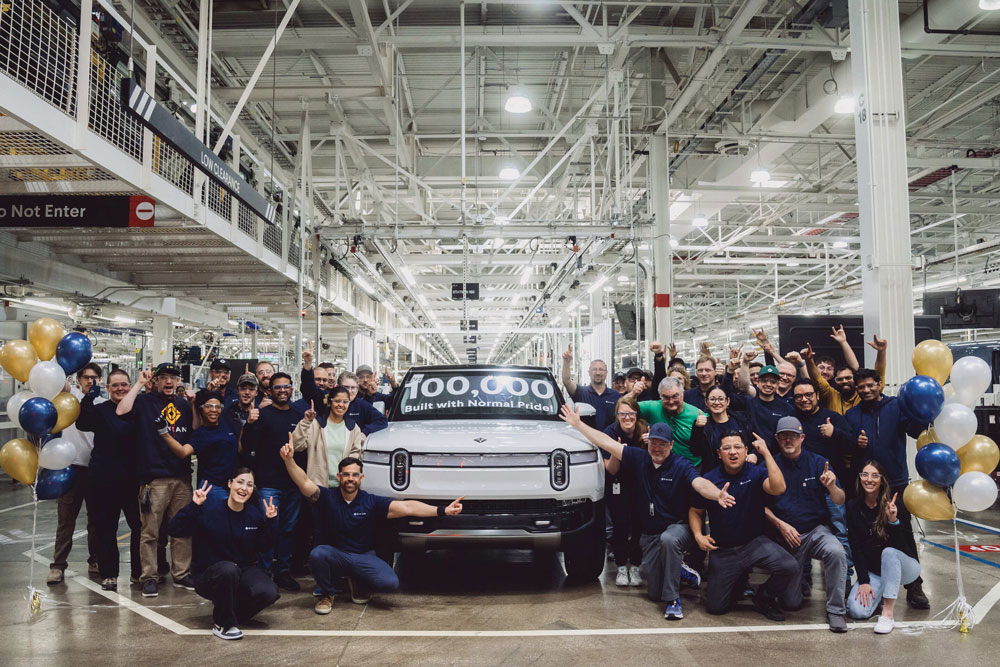
Rivian arrived in Normal in 2017 upon acquiring a former manufacturing facility operated by Mitsubishi Motors.
Photo courtesy of Rivian
“We are excited to see this supplier park coming together so quickly,” said Rivian Founder and CEO RJ Scaringe in May 2025. “This will be a key enabler to increasing production at the plant in 2026 when we start to build R2 in addition to R1 and our commercial vans.”
Outside of automotive success, North Central Illinois has found favor in the ever-evolving life sciences industry. Singapore-based medical equipment manufacturer Epic Medical is coming to Tazewell County’s city of Pekin to establish the company’s first U.S. production facility. The $25 million intravenous (IV) solutions plant will be constructed at the Riverway Business Park on over 66 acres the company purchased in March. By the end of 2026, Epic Medical hopes to expand its presence in the U.S. market, creating 100 new jobs.
A robust array of universities and community colleges work closely with regional employers when crafting new degrees, curriculum or training programs. Illinois State University, Heartland Community College, Illinois Central College and the University of Illinois Medical School are a few located throughout the 10-county region. This collaboration has proved vital for prospective students and a local workforce of over 300,000 to obtain the relevant skillsets or upskilling opportunities needed to land a quality role.
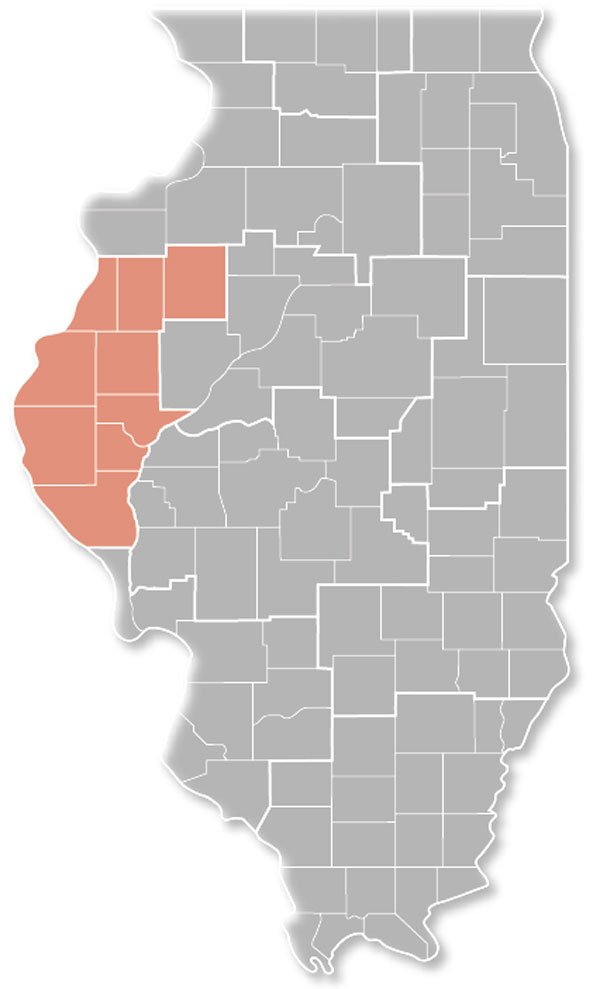
West Central
Counties: Adams, Brown, Hancock, Henderson, Knox, McDonough, Pike, Schuyler, Warren
In West Central Illinois, agriculture has been the backbone of generations of economic growth. These rolling hills and prime farmland bolster the state’s overall agricultural output for leading crops like corn and soybeans, while providing a fertile landscape for a food processing and manufacturing industry to thrive.
Thrushwood Farms Quality Meats, now a subsidiary of Western Smokehouse Partners, announced the company would revamp a former 179,000-sq.-ft. Maytag manufacturing site in Galesburg that has sat dormant for over 21 years. The $50 million investment will allow the company, which was originally founded in the city, to increase current production capacity of its snack stick products. The City of Galesburg supported the project with a $1 million investment, following Thrushwood Farms’ 10-year lease commitment and the creation of up to 180 new jobs.

Quincy is located in Adams County along the Mississippi River, bordering Northeast Missouri.
Photo courtesy of Illinois Office of Tourism
“We believe in the potential of this community and are excited to create new jobs that will provide stability and prosperity for local families,” said Western Smokehouse Partners CEO Matt Bormann. “This project will not only increase our production capacity but also strengthen our ties to the community, fostering a collaborative environment.”
For companies like global wheel and tire manufacturer Titan International and aerospace components supplier Pegasus Manufacturing, establishing an HQ in West Central Illinois introduced plenty of space to innovate. The region’s nine counties — Adams, Brown, Hancock, Henderson, Knox, McDonough, Pike, Schuyler and Warren — support not only the ability to grow, but to move.
West Central Illinois’ proximity to both the Mississippi and Illinois rivers, highway, Interstate, commercial airports, short line and Class I rail have not gone unnoticed by transportation and logistics industry players.
Those logistics factors led Amazon to choose the city of Quincy to construct a new “last mile” warehouse and distribution facility. The project, which went into motion in November 2024, will introduce a 59,000-sq.-ft. distribution center that will aid the company in better serving West Central Illinois, in addition to the the tri-state region encompassing Northeast Missouri and Southeast Iowa, before 2026.
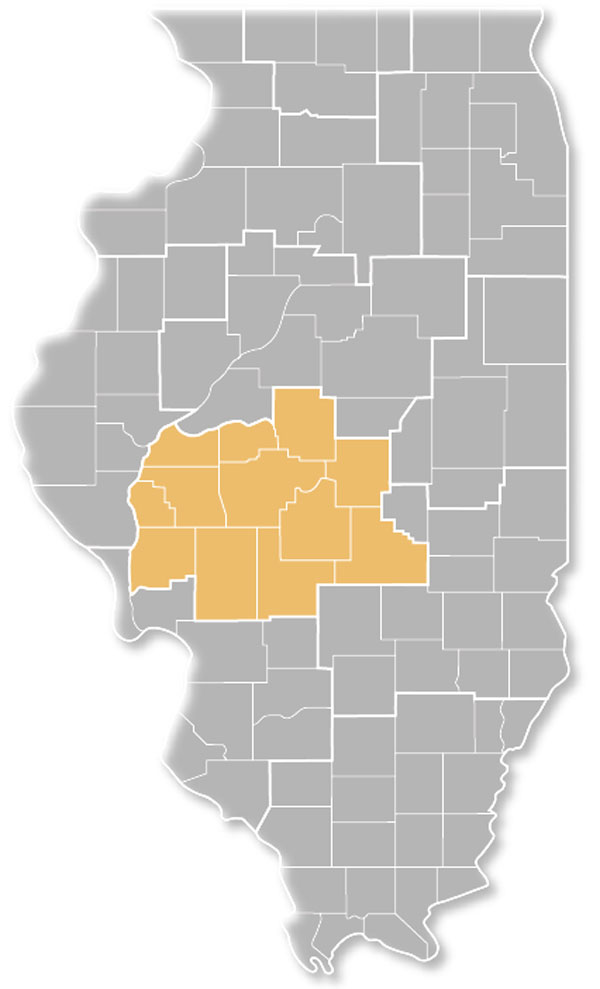
Central Region
Counties: Cass, Logan, Menard, Macon, Morgan, Sangamon, Scott, Christian, Greene, Macoupin, Montgomery, Shelby
The Central Illinois region is a 12-county area anchored by the state capital of Springfield. Other regional hub cities include Decatur, Jacksonville, Lincoln, Taylorville, Litchfield and Carlinville. The area’s largest employer reads like a Who’s Who of the Fortune 500: Archer Daniels Midland; Blue Cross Blue Shield; Norfolk Southern; Primient; Mueller; and Wells Fargo Home Mortgage.
With a population of over 550,000 and a labor force of 270,000, Central Illinois has access to 90 million people within a day’s drive. Top manufacturing sectors include paper manufacturing and printing; food processing; fabricated metal manufacturing; hospitality and tourism; and health care.
One of Central Illinois’ chief assets for industry is the Midwest Inland Port in Decatur in Macon County. This multimodal transportation hub offers shippers easy access to the Midwest and all three coasts: East, West and Gulf.
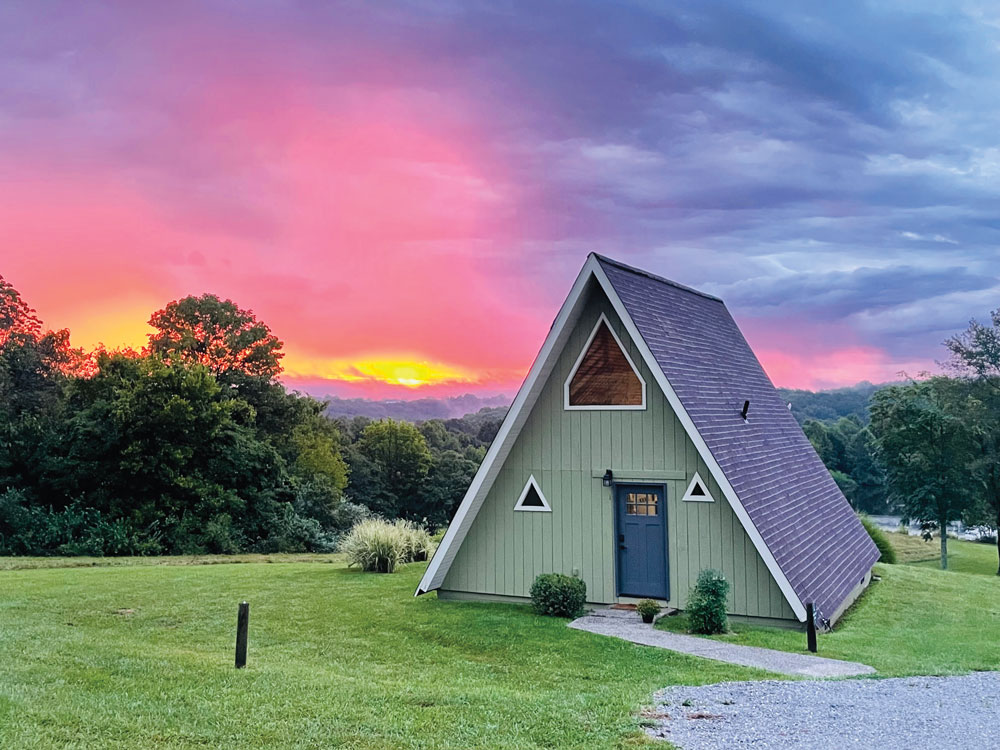
Sunrise Hill is in Montgomery County in the Central Region.
Photo courtesy of Illinois Office of Tourism
Among other port benefits are the following:
- Strategically located, this logistics complex offers non-congested, toll-free access to one of the country’s heaviest trucking and railway traffic flows.
- Served by two Class I railroads and short line (CN, NS, Watco) connecting to all North American rail networks.
- Intermodal ramp with 25-minute average turn times.
- A quick channel to coastal and export markets.
- Abundance of competitively priced labor and an available workforce.
- An airport equipped with a Fixed-Based Operator (FBO) and an 8,500-foot main runway. Daily passenger service provided to Chicago through United SkyWest.
- A diverse community of importers and exporters in the area creates opportunities for intermodal container match-back shipments.
- Rail-serve LEAF Gen-Set locomotives, which reduce Nitrogen Oxide emissions by 84% compared to conventional locomotives and operate using 45-60% less fuel.
- Third-party logistics providers offer freight forwarding, transloading, warehousing, stock management, temperature-controlled storage and more.
- Reduced supply chain logistics costs.
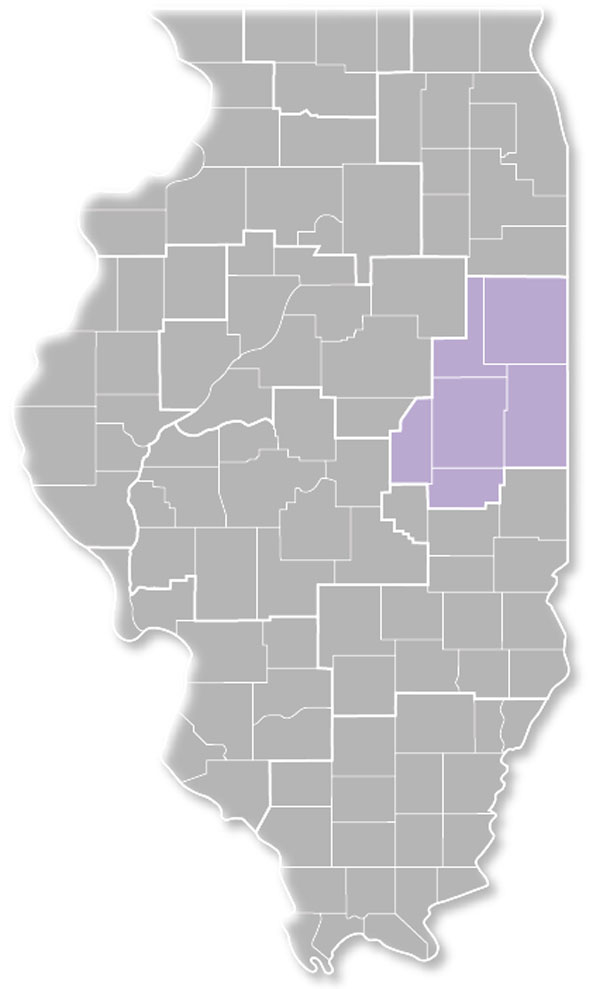
East Central Region
Counties: Ford, Iroquois, Champaign, Piatt, Vermillion, Douglas.
The six-county region of East Central Illinois is anchored by Champaign, home to 88,822 people — the largest city in the region. Home to the University of Illinois, the city annually hosts over 56,000 college students from all over the country and the world. The ninth-ranked public university in the U.S., the school since its founding in 1867 has produced 29 Pulitzer Prize winners and the inventor of the first graphical web browser.
Due to the presence of UIUC, key industries in this region include R&D, manufacturing, health care and education, but the region also hosts sizable sectors in distribution, agriculture and food processing. The largest manufacturers in East Central Illinois are Danville Metal Stamping, Kraft Heinz and Plastipak.
With a total population of 361,000 and a workforce of more than 160,000, East Central Illinois produces one of America’s most skilled labor pools for engineering, R&D and life sciences. The Research Park at University of Illinois Urbana-Champaign is home to 2,100 people working at over 120 companies that also employ another 800 student interns.
The Carle Illinois College of Medicine at UIUC is the world’s first engineering-based school of medicine. Established in 2015, the school is leveraging advanced technology to train physician innovators and other specialists in the medical field.
East Central Illinois is also a bustling center for corporate headquarters. Among the many firms operating head offices in the region are Busey Bank, Frasca International, Litania Sports Group, Horizon Hobby, Watchfire Signs and Wolfram.
Look for more to join them soon. For example, Serionix was recently ranked by Inc. Magazine as a member of the Inc. 5000 list of fastest-growing companies in the U.S. Checking in at No. 346, Serionix is based in the university community of Champaign-Urbana. As reported by Site Selection Editor Adam Bruns last year, “The company’s founders were University of Illinois graduate students who adapted air filter technology created for NASA for home furnace use in a product called Colorfil, made for homes with pet owners. ‘The main active ingredient in our patented coating is citric acid, which is naturally occurring and commonly found in fruit,’ the company said.”
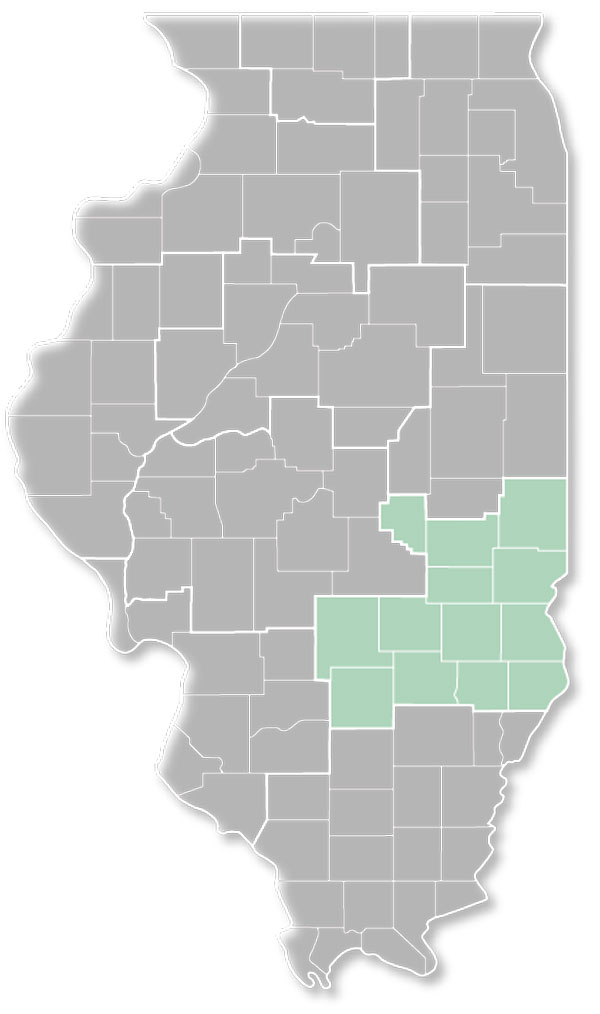
Southeast Region
Counties: Coles, Clark, Cumberland, Edgar, Effingham, Moultrie, Crawford, Fayette, Jasper, Clay, Lawrence, Marion, Richland.
With 272,400 people, the 13-county region of Southeast Illinois boasts a highly diversified economy that is anchored by its three largest economic hubs: Charleston, Mattoon and Effingham. Much of this region shares a border with Indiana, which is separated from Illinois by the Wabash River.
Ronda Sauget, president and CEO of Coles Together in Mattoon, says that “we have a lot of industry from multimodal transportation because we are in the center of the U.S. We are on the Canadian National Railway line. They have a 2.8-mile-long rail yard in Mattoon. It is a very busy multimodal hub here. We are two hours from the Mississippi River, two hours from Indy and two hours from Chicago.”
Due to these transportation and logistics assets, “a lot of manufacturers are here,” says Sauget. “Mars Pet Care, Mattoon Precision; North American Lighting; Bimbo Bakeries — they are all here. Bimbo makes 9 million Lender’s bagels weekly from their plant here.”
Available sites make Southeast Illinois appealing to investors, she adds. “We have a good inventory. Agracel has two sites here. We got a $3 million grant from DCEO to build out electrical capacity for a shovel-ready site on Highway 57. We have the CN Prairie Park site — a certified rail-served site of over 500 acres.”
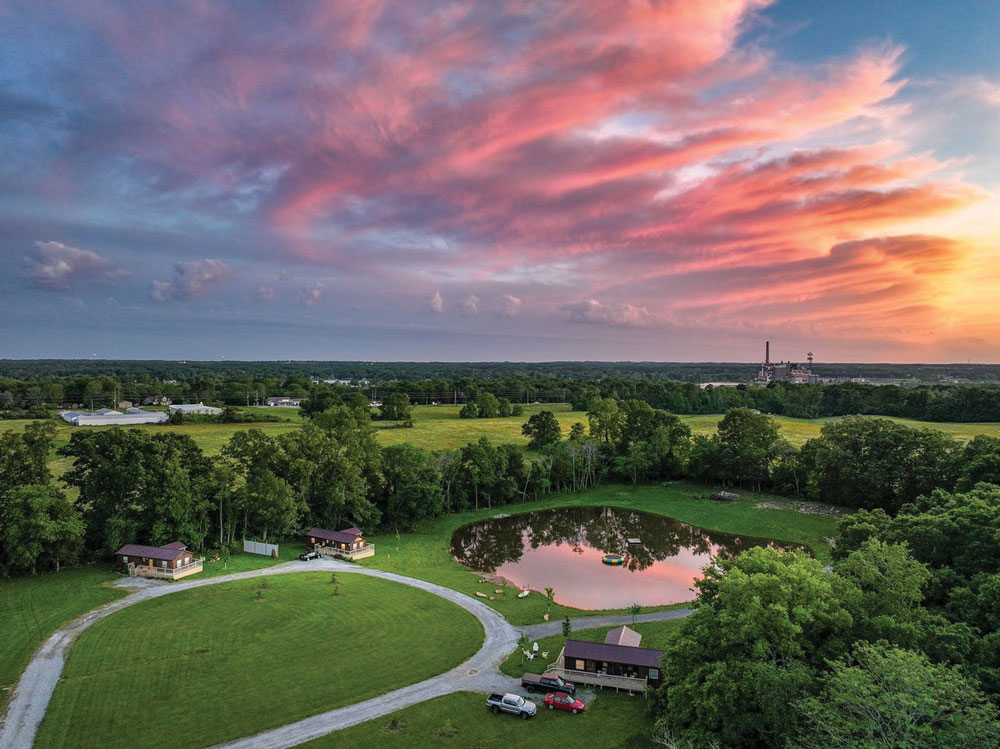
Dam near Lake of Egypt Cabins is in Marion County in Southeast Illinois.
Photo courtesy of Illinois Office of Tourism
Among other regional assets, she notes, are an extensive educational system with Eastern Illinois University in Charleston and a community college system that puts together customized programs for employers, including tailored upskilling programs.
“Also,” she says, “this area has one of the highest safety ratings in all of Illinois. That is a big deal. We have the $200-million mixed-use sports complex built by Rural King (see sidebar). That brings 5,000 to 6,000 people to town on some weekends.”
Sauget adds, “Tertiary markets like this are highly desirable because of our productivity. We offer a highly productive and stable workforce, a low cost of living and ease of operations. It is easy to get up and running here. Local government is very business-friendly; the local schools are good; and the turnaround time for companies is competitive. You can lease or buy space for 25% less here than you can in larger markets. Wages tend to run lower here with higher productivity. And there are 821,000 people living within a 60-mile radius. Our region is a hidden gem for industrial brokers.”
Her elevator speech to prospects is simple, she says: “If you are a company and you are looking to locate in a micro market, know that companies come here and they don’t leave.”
Joe Dively, chairman and CEO of First Mid Bank & Trust in Mattoon, says his regional bank with $6.5 billion in assets under management is ready to help those firms grow. “I am from Charleston just nine miles down the road,” he says. “This is a great part of the country. We wanted to raise our family here. I am a big believer in what community banks do. We bring capital to families and help businesses grow.”
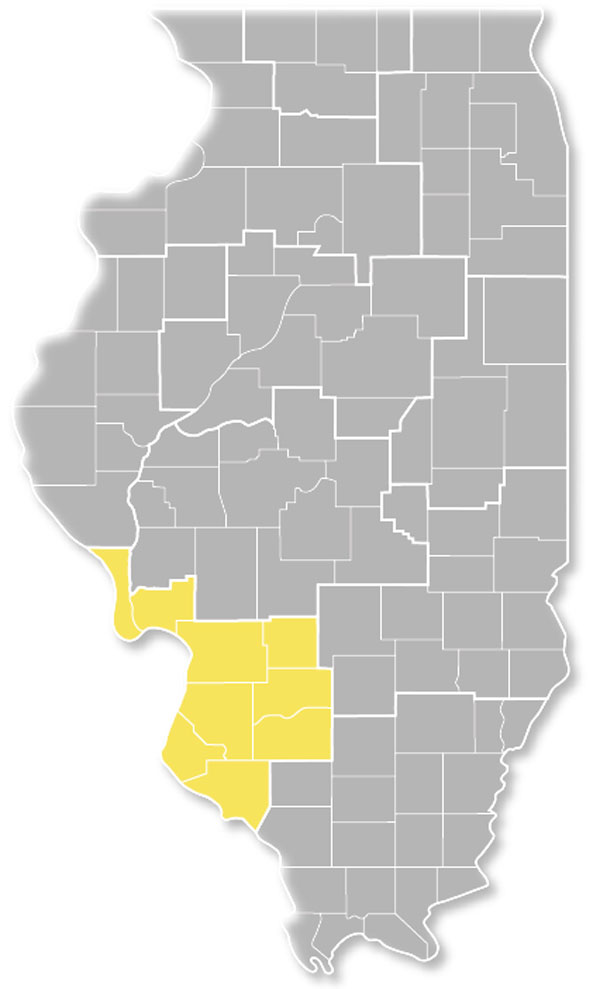
Southwest Region
Counties: Calhoun, Jersey, Madison, Bond, Clinton, St. Clair, Monroe, Randolph, Washington.
Much of the economy of Southwest Illinois is intertwined with that of the Greater St. Louis metro area. Located just across the Mississippi River from St. Louis, Southwest Illinois has nine counties that collectively are home to 685,000 residents and a workforce of 275,000.
Belleville is the largest city with over 42,000 people, while Collinsville, Edwardsville, O’Fallon and Alton are also sizable employment centers in the region.
Kyle Anderson, executive director of the Leadership Council of Southwestern Illinois, says that his region’s best-kept secret is how well educated its residents are. “We are the biggest producer of bachelor’s degrees in the entire St. Louis region. That school is Southern Illinois University-Edwardsville. It outpaces every other higher-education institution in the region in churning out new bachelor’s degree graduates every year,” he says.
He adds that “we have great assets through University of Illinois being only two hours away. We have one of the best community college partners too. We are big enough that our population can handle any size company that wants to come here; but we are also small enough that we can craft a training program just for you.”
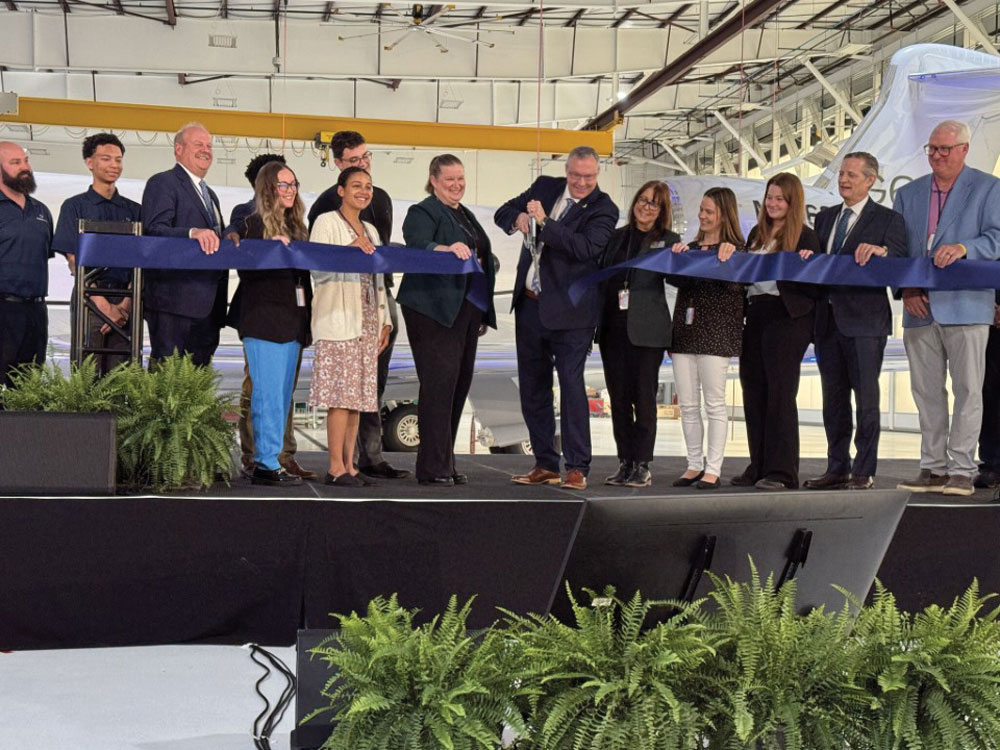
Gulfstream Aerospace recently expanded in Southwest Illinois.
Photo courtesy of Ameren Illinois
Anderson cites Southwest Illinois College and Westar Aviation as an example of a good partnership. “With a grant from the counties, SWIC came on the Westar campus and trained over 50 workers and graduated them in a year,” Anderson notes. “We have a concierge service to prepare that training program for them.”
Another regional economic engine is Scott Air Force Base. “That base produces $8.3 billion a year in direct economic impact,” Anderson adds. “We have 57,000 veterans living in the Greater St. Louis Region. We have the best trained workforce in America in our backyard. They show up every day, take great pride in their work and work very hard.”
Anderson says that quality of life is a huge drawing card. “We are only 25 minutes away from the St. Louis Cardinals, St. Louis Blues or St. Louis City SC,” he notes. “We are a very safe area, and we offer affordable and high-quality housing.”
Industry diversification is another advantage, he says. “We have a very diverse economic ecosystem. We are not dependent on any one industry sector. We have a great manufacturing presence, a growing geospatial presence and Scott AFB. And we are known for our logistics. We are a day’s drive to 50% of U.S. consumers and a two-days drive to 85% of U.S. consumers. Our railroads, our ports, our connectivity — we have one of the largest inland ports in the country. We have three Interstates going through downtown St. Louis. You can get anywhere in the U.S. very quickly through here.”
With major firms like Boeing, Gulfstream, Prairie Farms and Tyson Foods expanding in the area recently, Anderson says the ground has been laid for major supplier growth as well.
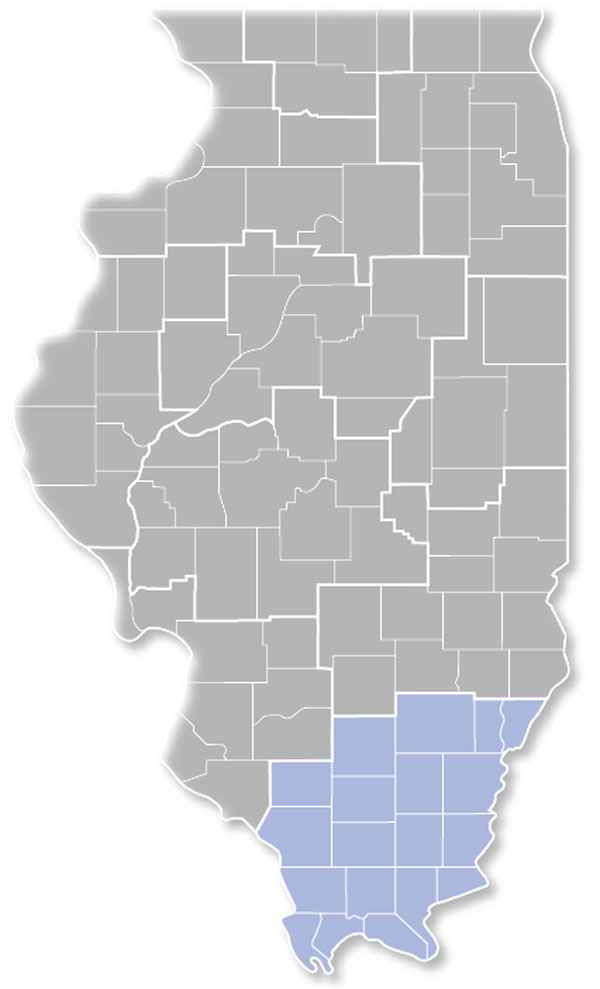
Southern Region
Counties: Wayne, Jefferson, Wabash, Edwards, Perry, Franklin, Hamilton, White, Jackson, Williamson, Saline, Gallatin, Union, Johnson, Pope, Hardin, Alexander, Pulaski, Hardin.
The largest city in the 19-county region that makes up Southern Illinois is Carbondale, with a population of 25,083 people. While Carbondale is located in Jackson County, the neighboring county to the east, Williamson, is actually the most populated one in Southern Illinois, with 67,030 people. Altogether, the region is home is around 400,000 people.
Southern Illinois towns may be small in population, but they make up for it in economic impact. Deb Barnett, executive director of Southern Illinois Now, says the focus of her economic development efforts is centered around the region’s transportation and logistics assets. She calls it the R4 Advantage: roads, river, rails and runways.
Bordered by the Ohio and Mississippi Rivers, Southern Illinois is a preferred destination for distribution warehouses. “We are a largely rural area that was known as a heavy coal mining region historically,” says Barnett. “We have a very strong manufacturing presence today. We are also home to Southern Illinois University-Carbondale, which is a Research 1 institution. There are five community colleges in our region, and we are centrally located in the Midwest. You can get to eight major metros within five hours.”

Big Rocky Hollow Trail is in Goreville in Johnson County in Southern Illinois.
Photo courtesy of Illinois Office of Tourism
Being located in the center of St. Louis, Nashville, Memphis and Indianapolis gives Southern Illinois a strategic advantage, she adds. “I-57 runs north to Chicago. I-64 runs west to St. Louis; and I-24 runs east and west through our region,” she notes. “Carbondale, Marion and Mount Vernon are the main commercial and industrial hubs, but all of the companies in our region benefit from the logistics assets we have.”
Those companies are growing too. “Aisin Illinois has three plants here. They are in the auto sector,” Barnett says. “They just built a 463,000-sq.-ft. logistics center. They benefit from being in the center of the country.”
Southern Illinois Airport near SIU-Carbondale is benefiting from this growth. “It has 30 companies on the airfield, and they are continuing to grow,” says Barnett. “We also have the Shawnee Hills Wine Trail, bike trails, hiking trails, coffee trails — you name it. We have trails for everything.”
With a cost of living that is 17% lower than the national average, Southern Illinois is a huge bargain, she adds. “You can get a really nice home here for around $200,000. I live on a lake on a point on the water, and my house was less than $300,000. It is just a matter of getting the word out — and we are working very hard to do that.”
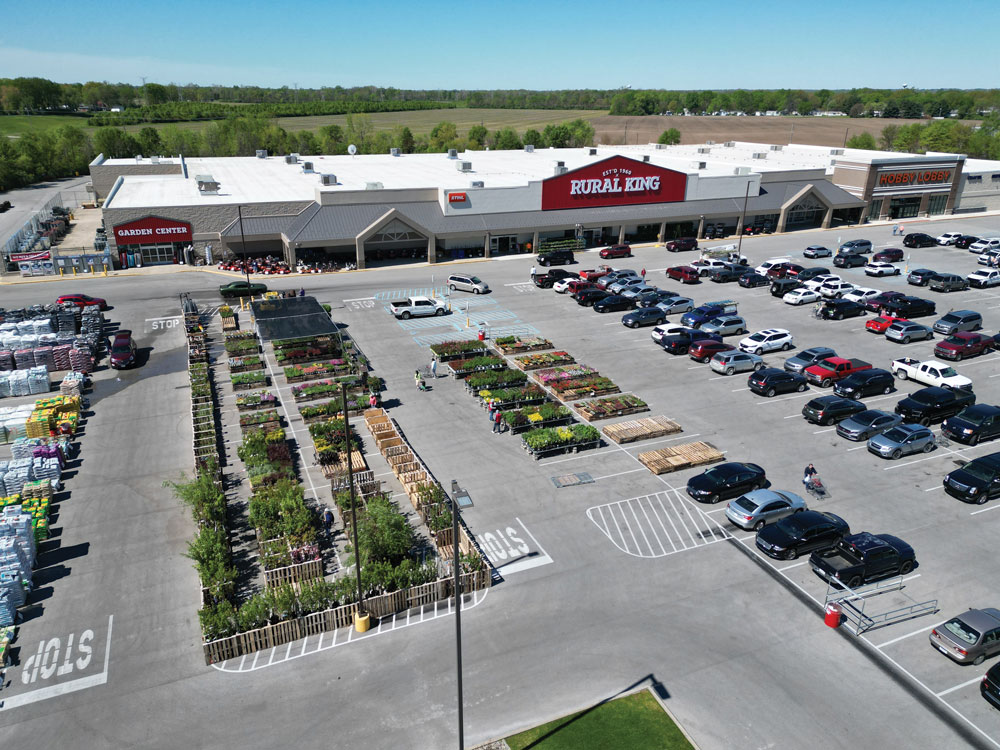
Rural King is a Mattoon-based rural farm goods retailer that is in expansion mode.
Photo courtesy of Rural King Real Estate
How a Mattoon Retailer Rose to King of Its Class
A $200-million mixed-use development promises to make Mattoon a regional destination for several reasons. That’s because farm goods and outdoor lifestyle retailer Rural King is using its real estate arm to build a walkable project with retail, restaurants, sports facilities and entertainment — the first lifestyle center of its kind in Coles County in Southeast Illinois.
Rural King, also known as RK Holdings LLP, is a classic American farm and home store that caters to the needs of its customers in the Farm Belt and beyond. With its roots firmly planted in Mattoon, Rural King has been steadily growing since its founding in 1960.
Today, the popular retailer employs about 9,000 people and operates around 150 stores in 17 states, stretching from the Upper Midwest to the Southwest Florida Coast. Rural King’s real estate portfolio now stands at 20 million sq. ft. owned or operated. The firm maintains its headquarters, main distribution center and flagship store in its city of origin, Mattoon.
We recently caught up with Blake Pierce, president of Rural King Real Estate, to learn more about the Emerald Acres development and the company that spawned it.
What does the Emerald Acres project entail?
PIERCE: The Shops at Emerald Acres Sports Connection was developed because we know we needed to attract and retain people in Mattoon. We are utilizing sports tourism to spur economic development. Rural King owned all this land out here and donated it to Mattoon Sports Complex Inc. I serve as president of that not-for-profit organization. The first thing we did was build a 140,000-sq.-ft. indoor sports facility on this 150-acre site. That opened in December of 2024. We just started construction on the outdoor fields for opening in the summer of 2026. Emerald Acres is aiming to have 580,000 visitors annually, bringing $23.8 million in economic impact to the area.
We’ve also constructed a shopping center with Ulta Beauty, Chipotle, Chick-fil-A, Ross, Texas Roadhouse and others. Fairfield Inn opens in October. Hampton Inn breaks ground this week. This is a real momentum changer for the area. Matton is a micro-hub in a rural area. People come from 30 to 40 minutes away on Saturday to eat and shop. This new project is our chance to make a good first impression of our community.
What kind of store expansions are you doing in other states?
PIERCE: We are targeting the East and Southeast. We opened 10 stores in 2025 including our entry into Mississippi, South Carolina and Maryland. We will open another 15 stores in 2026. We will have 150 stores by the end of this year. We are able to expand because we are privately owned. We don’t have any outside capital or debt. That allows us to make generation-to-generation decisions and not day-to-day ones. We also sell a diversified and unique product offering.
Our typical store footprint is around 83,000 sq. ft., and we carry much more than just farm goods. We carry firearms and ammunition. We carry some consumable products. We carry sub-compact tractors. We have a clothing area of 8,000 to 10,000 sq. ft. We also compete on price. We operate as a low-cost retailer and offer the best price every day.
We are more of a destination because of the size of our stores. The Farm & Ranch sector is very segregated. The industry was started to serve the farmer and rancher. Most of these chains came about in the 1950s and 60s. Back then, a 40-to-80-acre farm could be worked by one family. Rural King was established to serve their needs.
Over time, farms grew in size. The average-sized farm now is 5,000 acres and is farmed by major corporations. Today, being in the farm and ranch sector means catering to folks who like to live the rural lifestyle — people who want the attributes of what our stores sell. They identify with the rural lifestyle. COVID saw a great migration to rural areas. Nowadays, many of our shoppers have more discretionary income and choose to live here just because they prefer a more rural lifestyle.
What are your store site selection criteria?
PIERCE: We only look to purchase locations today. We do not lease. We go into primarily second- and third-generation space. That keeps costs down. We can go in and take over an old Kmart box and use that space. We need large parking lots because we have large garden centers. Our minimum is 10 acres. Here are our other key criteria:
- Trade area of 50,000 population.
- Too urban of a market is not a good fit.
- Too high of income is not a good fit. We target the working class.
- We prefer to be on main and main, but we are a destination. Our typical customer drives 30 minutes to see us.
- Our stores are rather minimalist in terms of buildout. Going into existing buildings is less expensive.
- We use an internal algorithm that projects sales based on location. We factor in things like population, traffic, cattle head counts, etc.
— Ron Starner
